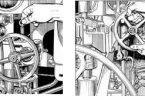- The indirect echoes will usually occur in shadow sectors.
- They are received on substantially constant bearings although the true bearing of the radar contact may change appreciably.
- They appear at the same ranges as the corresponding direct echoes.
- When plotted, their movements are usually abnormal.
- Their shapes may indicate that they are not direct echoes.
SIDE-LOBE EFFECTS
Side-lobe effects are readily recognized in that they produce a series of echoes on each side of the main lobe echo at the same range as the latter.
Semi-circles or even complete circles may be produced. Because of the low energy of the side-lobes, these effects will normally occur only at the shorter Ranges . The effects may be minimized or eliminated through use of the gain and anticlutter controls. Slotted wave guide antennas have largely eliminated the side-lobe problem
MULTIPLE ECHOES
Multiple echoes may occur when a strong echo is received from another ship at close range. A second or third or more echoes may be observed on the radarscope at double, triple, or other multiples of the actual range of the radar contact .
SECOND-TRACE (MULTIPLE-TRACE) ECHOES
Second-trace echoes (multiple-trace echoes) are echoes received from a contact at an actual range greater than the radar range setting. If an echo from a distant target is received after the following pulse has been transmitted, the echo will appear on the radarscope at the correct bearing but not at the true range.
Second-trace echoes are unusual except under abnormal atmospheric conditions, or conditions under which super-refraction is present. Second-trace echoes may be recognized through changes in their positions on the radarscope on changing the pulse repetition rate (PRR); their hazy, streaky, or distorted shape; and their erratic movements on plotting.
A target pip is detected on a true bearing of 090° at a distance of 7.5 miles. On changing the PRR from 2000 to 1800 pulses per second, the same target is detected on a bearing of 090° at a distance of 3 miles. The change in the position of the pip indicates that the pip is a second-trace echo. The actual distance of the target is the distance as indicated on the PPI plus half the distance the radar wave travels between pulses.


